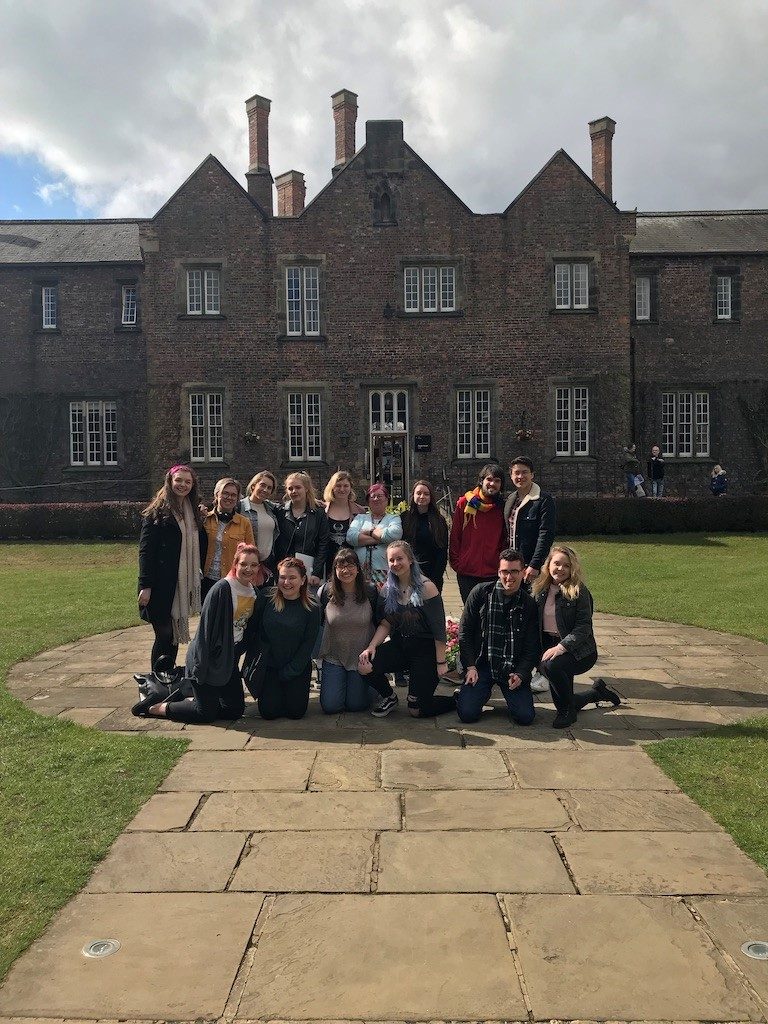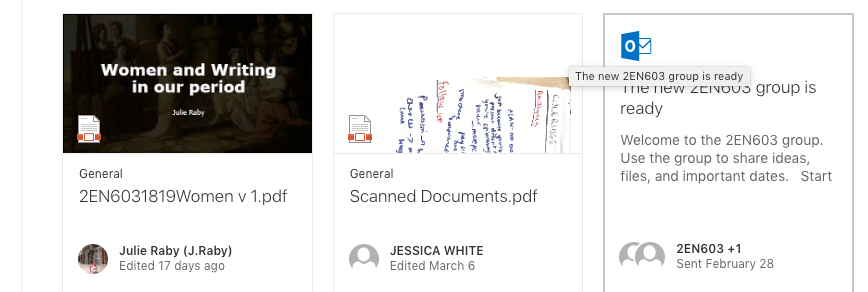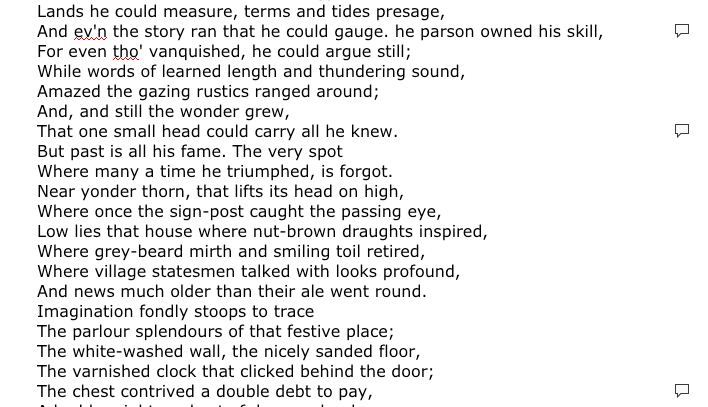
Summary of approach/tool
Microsoft Teams is a digital hub that brings conversations, content, and apps together in one place. Using Teams you can create collaborative classrooms, where students are able to work simultaneously on documents and easily share materials and ideas. You can also use a range of Microsoft and non-Microsoft tools to work together within Teams more effectively.
Member of staff: Julie Raby
School: Humanities, Religion and Philosophy
In this blog post, I reflect on my experience of using Microsoft Teams to develop a close textual reading activity using Oliver Goldsmith’s ‘The Deserted Village’ in the Level 5 second semester Literature module, 2EN603 Revolution and Response: British Literature 1740 to 1840. My aims were to present students with an opportunity to develop their close textual reading skills and also to encourage debate in the classroom which would be underpinned by the students’ analysis of Goldsmith’s poem. In the blog post, I discuss how the activity was set up, and what was successful, as well what was a challenge. In addition, I reflect on how I might make use of Microsoft Teams in the future. What became apparent through the process of using Microsoft Teams and reflecting on how well it worked in the seminar scenario, I realised there was also the potential to work with students to support what Mike Neary and Jess Winn describe as “[…] the development of collaborative relations between student and academic for the production of knowledge”(137). In the blog post, I will explore how the activity facilitated a wider objective which was one that involved academic/students as coproducers in the learning process as well as coproducers l in producing knowledge.
In his preface to How to Read Literature, Terry Eagleton states, “Like clog dancing, the art of analysing works of Literature is almost dead on its feet. A whole tradition of what Nietzsche called ‘slow reading;’ is in danger of sinking without trace” (x). It may seem surprising that Eagleton should start his book on the study of Literature and suggest that ‘slow reading’ is in danger of sinking without trace when it the foundation of our practice as literary critics. In his recent book, Literature. Why it Matters, Robert Eaglestone states that “close reading-looking at a text in intense detail – is one of the most important activities of literary studies: not a methodology but a ‘persistent feature, or practice (43). In the English Literature programme (and associated joint honours) at York St John University, close textual reading is an essential skill, and close textual analysis is at the foundation of everything we do in our programme. Indeed, the programme slogan is currently ‘Words Matter’, illustrating the importance of the study of language in our discipline.
In my pedagogical practice, and also for colleagues in the English Literature programme team, constant reference to the detailed reading and analysis of text is included in seminar activities and lectures. What might be an issue for students is that because close reading seems such an obvious Discipline skill, some students may not be conscious that what they are actively engaged in is close textual reading. The skill can easily be perceived as something that feels nebulous, and as something tutors need to, or should, explain. The art of close reading can become a mystery that has to be solved for students to succeed.
Close textual reading is one of the activities that students often comment they want more help with. In some cases, students associate close reading with the type of activity they might have undertaken around ‘A’ Level study and akin to reading a text in the classroom with the tutor leading the activity and explaining and making meaning. Indeed, the tutor is then creating a product which is delivered to the students as something they take away with them whether as the form of notes but also as content knowledge.
One of the perceived major transitions from ‘A’ Level to University study is that at University, it is expected (actually required) that students will have read the primary texts before they come to the seminars and lectures. In the face to face sessions we often talk about passages of text that students have read. The focus is then on debate based on what students have done in preparation rather than on what they are doing at that moment in time. I was interested in building activities which would support students in developing their close textual reading and analytical skills in a class room environment, so that they would be more confident to undertake the practice in the independent learning time. In taking this approach, one of my learning objectives was to support students to utilise these skills outside the classroom in enabling them to prepare for the face-to-face discussion in seminar. However, another learning objective, and one that is becoming more important for me, was around the quality of the debate that happens whilst students are undertaking an activity. I was also keen to observe the deep learning that can take place in the group as they support each other, and problem solve, as well as share ideas. I would consider in the process of deep learning the coproduction of knowledge as well as skill development is taking place. Neary and Winn describe coproduction as:
The point of this re-arrangement would be to reconstruct the student as producer: undergraduate students working in collaboration with academics to create work of social importance that is full of academic content and value, while at the same time reinvigorating the university beyond the logic of market economics (126).
I realise that Neary and Winn are presenting the outcome as something that is concrete in terms of a knowledge that is produced through student/academic collaboration. They discuss the coproduction as something that could be a research output rather than a process or practice. What I wanted to do was build on the idea of student/academic coproduction and develop activities which were about skill development with the focus was on students and tutors working together. The reason I moved to trying Microsoft Teams in the classroom was because I wanted to explore ways in which I could work with the students on a poem or passage of text in the classroom and shift the emphasis from tutor delivery to student practice.
Last semester, I taught a Level 6 Module on Shakespeare. The students had suggested in mid-module feedback that it would be helpful to have more support with close textual reading. At first, I was surprised because at Level 6, I felt the students would have developed their close reading skills throughout their first two levels of study. I had not seen evidence of the students in the group struggling with close textual reading. I considered a variety of ways to engage them jointly in an activity which would make it clear that they were already undertaking close textual reading all the time when they were undertaking other activities and in their preparation for the seminars, but also to build their confidence in becoming and understanding themselves to be critical readers. Two things had become apparent were that most students were undertaking close reading but weren’t always clear that this is what they were doing, but more importantly, they were often unclear what do with what they learnt or gleamed from the exercise of text analysis. Eaglestone notes students are not always aware of what “kind of reading is a practice and an activity?” (43). It became clear that some of the support that I might offer was probably more about how to articulate what the students learnt from the reading as part of a process in becoming critical thinkers and writers.
In the seminar on the Shakespeare module, I used my iPad and a PDF annotating tool to work on a passage from Macbeth on the screen in the classroom, and the students had their own paper copies of the passage. The activity worked to some extent, but the students tended to stop working with each other and watch me working. The initial idea that tutor and students would coproduce the knowledge had shifted to become an activity that was tutor-led. I realised that it might be more useful to try and find a way that student and tutor could work together ‘in real time’ and analyse a passage of text or poem that reinstated the balance for tutor and students as collaborators. In researching the possibilities for in classroom online activities, I realised we could share and collaborate on documents using a variety of software and apps. In exploring the potential of Microsoft Teams, I realised that the software made it easy to set up a group of students and send them a link to the activity document days before the session via the Microsoft Team software.
In the session where I trialled Microsoft Teams, there were 16 students working at the same time on Goldsmith’s poem. The activity followed a lecture delivered by my colleague Dr Adam J Smith where he had modelled close reading of an eighteenth-century poem. The students were, therefore, putting what they had learnt in the lecture into practice in the following seminar. What was key here was that the students were following on from a lecture where they perceived that had learnt about poetry and here they were learning about another poem, and they were not necessarily thinking about the skills they were putting into use. As Eaglestone has reiterated the “you can only learn skills in context, or, as the jargon has it, ‘embedded’ in undertaking an activity” (81), and the context for the activity became one of the important reasons that the activity had some success.
There were both benefits and challenges in setting up the analytical activity. It took some time for me and the students to really understand how and what we inputted appeared on the screen in front of us. That issue manifest itself because there was a different experience in using the software on my own device and the experience of actually displaying it on the classroom computer for the whole group to work on. The WIFI signal in our classroom was not very strong, and as students had to both download the app and document which took a little bit of time to start the activity than I had planned. I had suggested before the session booking out iPads and laptops from ILE, but most students preferred to work on their own devices and laptops.
Generally, students enjoyed the session, and there was lots of discussion about the poem and about working together using the software. I learnt that the students needed more preparation in using Microsoft Teams. Some students had printed out the poem and said they preferred to annotate the paper copy rather than work online. However, if as Eaglestone usefully explains “criticism is a collaborative activity, shared between people, arising out of conversation, argument, shared thought (100), the experience isn’t just around the individual student activity (of thinking and annotating), but the conversations that students have which become a form of collaborative literary criticism. This presents the opportunity to discuss how the students arrived at this point.
What became apparent when using Microsoft Teams for the Goldsmith activity was the potential to do lots of other different types of activities with the students and also the students could use Microsoft Teams to collaborate with each other in a variety of other ways. For example, the students delighted in using the chat function to say hello to each other online, even though they were in the same room together. I realised that the collaboration could happen inside and outside the classroom space and the lines between different learning spaces were becoming increasingly blurred.
One of the key benefits of the activity was that students had to work together to problem solve in order to work out how to annotate the poem. The students had to discuss the text with each other and make decisions about the content of the annotations. Having set the activity up, students were able to access to the group work afterwards, but more importantly the students could also continue the activity in independent learning time and outside the timetabled classroom time.
I will definitely use Microsoft Teams in future for close textual reading activities. I would change some of the ways I approached the activity. For example, I would start off with a short virtual activity and when I came to work with the students in class, I would check that the students had downloaded the software and document at the start of the session in preparation for the activity taking place later in the seminar. I think I would use a break in teaching for students to find a physical space with good WIFI to download the document and software if they needed to.
Even though there were some teething troubles, there were not major issues, and they were ones that could easily be addressed. I could see that Microsoft Teams has lots of potential, and one of the things that I think will alleviate some of the issues in the set up would be to be using the software throughout the module as a Virtual Learning Environment (VLE).
Moodle has its place, and I have found it useful. The issue I have with Moodle is that it works best when everything is easily accessible via the landing page, because students don’t want to click through lots of links to find resources and information. However, Moodle can become very quickly cluttered with a mixture of information and activities, which works against making Moodle a dynamic interactive and collaborative space. Even with careful pruning, the ‘scroll of death’ tends to take over.
Over the Summer, I intend to experiment with Microsoft Teams as a VLE space and I would like to develop activities that build on the learning in the classroom, as well as support preparation and work towards the assignments. I am hoping that Microsoft Teams will encourage more collaboration amongst students outside the face to face teaching time, and the software will make it possible to foreground the interactive activities, rather than the information files, which could be stored behind the interactive space. The intention would be to create a student focused space and the more didactic documents and instructions would be accessible behind this space. I am hoping that it would then be a space for me, an academic and tutor, to collaborate with students online and classroom and online spaces would become much more complementary than they are now.

Julie Raby, Senior Lecturer in English Literature at York St John University.
Works Cited
Eaglestone, Robert. Literature. Why it Matters. Polity Press 2019
Eagleton, Terry. How to Read Literature, Yale University Press, 2013.
Neary, Mike and Winn Joss ‘The Student as Producer: Reinventing the Student Experience in Higher Education’ in Bell, Les, et al. The Future of Higher Education: Policy, Pedagogy and the Student Experience, edited by Howard Stevenson, Bloomsbury Publishing PLC, 2009.



0 responses on "Case Study: Using Microsoft Teams to analyse text in a face to face collaborative environment"